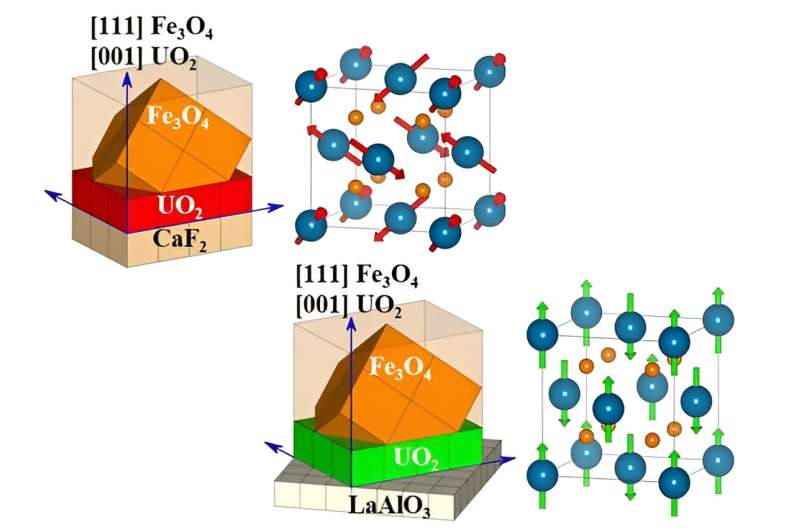This article has been reviewed according to Science X's editorial process and policies. Editors have highlighted the following attributes while ensuring the content's credibility:
fact-checked
trusted source
proofread
Spintronics research finds magnetic state of certain materials can be switched using surface induced strain

Electronics are based on electrical charges being transported from one place to another. Electrons move, current flows, and signals are transmitted by applying an electrical voltage. However, there is also another way to manipulate electronic currents and signals: using the properties of the spin—the intrinsic magnetic moment of the electron. This is called "spintronics," and it has become an increasingly important field in contemporary electronic research.
An international research team involving TU Wien and the Czech Academy of Sciences has now achieved an important breakthrough. They have managed to switch the spins in an antiferromagnetic material using surface strain. This could lead to an important new line of research in electronic technologies. The research is published in the journal Advanced Functional Materials.
"There are different types of magnetism," explains Sergii Khmelevskyi from the Vienna Scientific Cluster Research Center, TU Wien. "The best known is ferromagnetism. It occurs when the atomic spins in a material are all aligned in parallel. But there is also the opposite, antiferromagnetism. In an antiferromagnetic material, neighboring atoms always have opposite spins." Their effects therefore cancel each other out and no magnetic force can be detected from the outside.
"In 2010, however, scientists at the TU Wien and the Czech Academy of Science came up with the idea that such antiferromagnetic materials have promising properties for spintronic applications," says Khmelevskyi. This was the start of the new research field of "antiferromagnetic spintronics," which has developed quickly ever since.
Intensive work was done recently by TU Wien, the Institute of Physics of Czech Academy of Sciences and Ecole Polytechnique (Paris). The biggest challenge was that the spins in antiferromagnetic materials are difficult to manipulate—but finding a way to manipulate them in a reliable and precise way is crucial. Only if magnetic states can be switched from one state to another in a targeted manner does it become possible to produce computer memory cells (e.g., MRAM).
Magnetic frustration: Tiny effects make all the difference
Manipulating ferromagnets is easy: It is enough to simply apply an external magnetic field to influence its internal magnetic properties. This is not possible with antiferromagnets—but there is a way out: You can work with surface strain.
However, this requires very specific types of crystals. Depending on the geometry and the arrangement of the atoms in the crystal, several different antiferromagnetic spin arrangements may be possible. The crystal assumes the state with the lowest energy. But it might be an situation when several different spin orders have the same energy. This phenomenon is called "magnetic frustration." "In that case, tiny interactions, which would otherwise play no role, can decide which magnetic state the crystal assumes," says Khmelevskyi.
Experiments with uranium dioxide have shown that mechanical stress can be used to compress the crystal lattice a tiny bit, and this is enough to switch the magnetic order of the material.
"We have now shown that antiferromagnets can actually be switched by utilizing the properties of the magnetic frustration existing in many known materials," says Khmelevskyi. "That opens the door to many exciting further developments in the direction of functional antiferromagnetic spintronics."
More information: Evgenia A. Tereshina‐Chitrova et al, Strain‐driven Switching Between Antiferromagnetic States in Frustrated Antiferromagnet UO2 Probed by Exchange Bias Effect, Advanced Functional Materials (2023). DOI: 10.1002/adfm.202311895
Provided by Vienna University of Technology





















